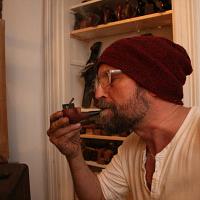
MaFe
in over 11 years
Fibonacci gauges #3: making the arms.
This is
part 3
in a
6 part
series:
Fibonacci gauges
Fibonacci gauges
making the arms.
Hi again Craftisan’s.
In the last part ended with ready made gauge arms, so we will go from there.
We have the long arms lined up here, with the drill bit going through to hold the aligned.
One gauge in Walnut, two in ash… say no more!!! Laughs.
Like this we can saw them to length on the table saw, but leave app. 0,5 cm extra.
As you see here after the saw cut, a little extra.
The same is done for the shorter arms.
Now cut, with that little extra.
The cross arms are just fine as they are.
I said a little bit extra, did you get it…
Going through my metal rods, I found these different sizes of brass.
You can use what ever you like, I just like brass, but a nail will do also.
I will go for the thin one, as no more is needed and I want as much wood as possible to support it.
The ends that will be the points of the legs, are now marked up with the centre, using a marking gauge, like I told earlier.
Looks fine and my hands like the hands of a working man…
Marking from other side.
An awl to mark centre, before we drill.
If that is not done, the drill might wander in the hole and we don’t want that.
Time to make a jig again!
Yes I want a safe way to cut the brass rods and have a small trick I like to use.
Some thin plywood get a saw cut.
Then I make a small piece of wood, with a width, of app. the deepness I want the rod to go into the end of the gauge arm.
Sawing a small rabbet that fits the rods size, just with a handsaw here, as the rod is thin.
It’s a match!
Super glue.
And glued onto the plywood.
Stick the rod into the hole and move the jig into the blade, you now have right length for each cut, but most of all a safe way to saw it.
The jig takes a few minutes to make, but then the sawing is done in an instant, so you save the time, at least when making three gauges here.
The rod here is 1,48 mm.
We need a 1,5 mm drill bit.
I can put it so deep in the drill press, that no stop will be needed, I can just go all the way in.
Again spending the time to make a setup, a scrap wood as side stop held with a clamp at 90 degrees.
Once the stop and table are locked in place, I can just go ahead drilling them all, by pushing them up to the stop.
And the rod fits, so I can go ahead.
Drill and repeat.
Mixing some epoxy.
Gauge arms and grass pins are ready.
With an ultra thin rod, app half the diameter of the hole, I make sure all the holes are well filled with epoxy, one by one.
The brass pins are put in place and the fit is so perfect, that they go in with a light tap.
Hot rods…
Goodnight for today, the epoxy will have time to dry until tomorrow.
See you soon.
Next time we will be making… a jig and little adjustments to a table saw sled and yes have a fully working Fibonacci gauge.
Hope it can be to some inspiration, or who knows hot rods…
Best thoughts,
MaFe
MaFe vintage architect and fanatical rhykenologist.
1 Comment
Main Street to the Mountains





































